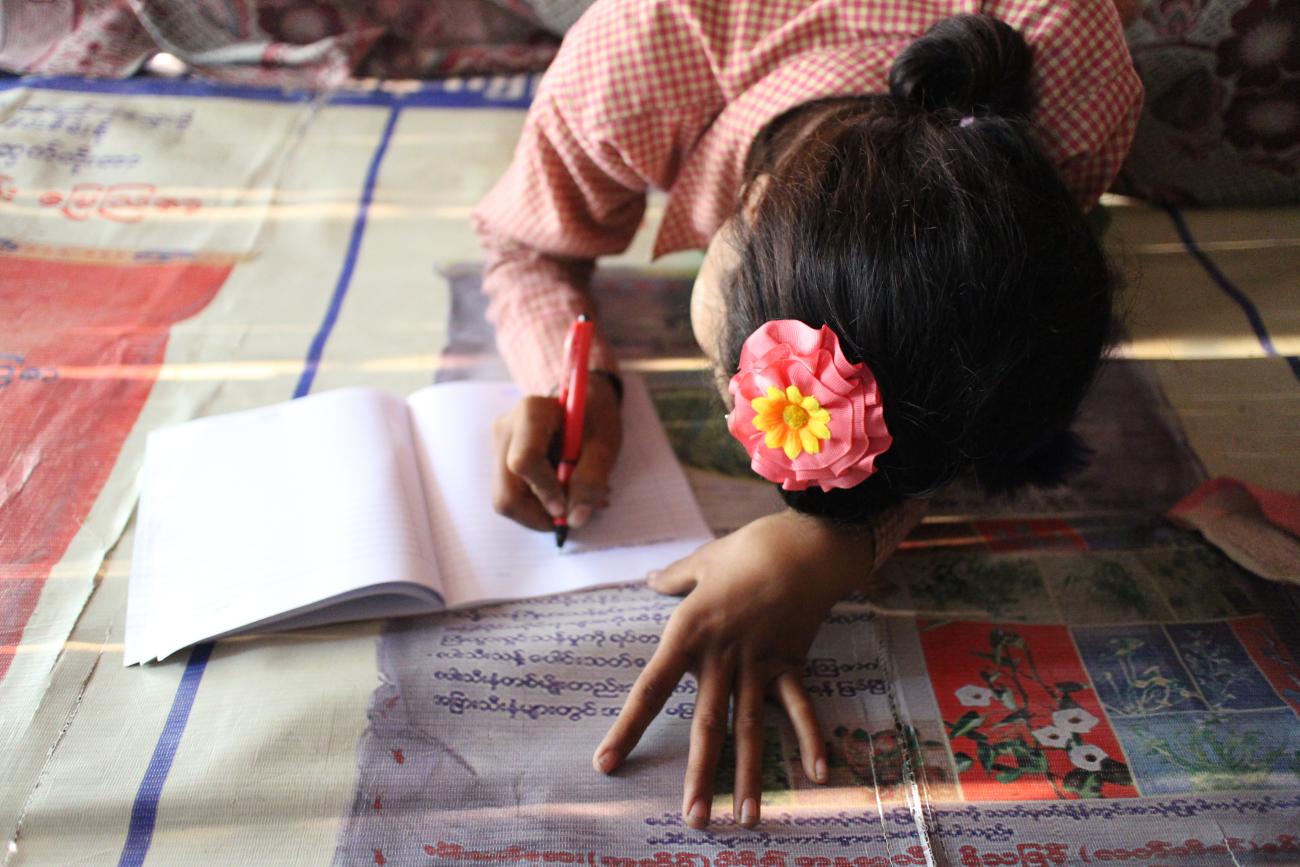More than a million Myanmar pupils returned to the classroom in late July but a surge in COVID-19 cases in recent weeks has forced schools to close again. Selim Benaissa, Chief Technical Advisor at the International Labour Organization (ILO), shifts the focus to those left behind – the one in 11 children trapped in child labour across the country – those who have had to drop out of school even before the pandemic. In the midst of a worsening health and economic crisis, is there still hope in the horizon for them?
When we first saw 12-year-old Khin, she looked much like any diligent schoolgirl doing her homework during the first week of term. With her hair pulled back neatly, she leant over her notebook, practicing writing with her favourite red pen, eyes narrowed in careful concentration. “My teacher is my idol,” she tells us. The sad reality is that Khin no longer goes to school.
“I had to quit school because my father got into a fight with a relative and died,” she explained. “My mother’s new husband wouldn’t let me stay, and I now live with my grandmother, doing temporary jobs like roof building, cutting bamboo and carrying firewood to support us.” We witnessed Khin and two other children lug piles of branches bigger than them to a boat for 2500 kyats. “It takes all of us an hour-and-a-half to do this job, though a single adult can do it in an hour,” she said.
In our work at the ILO, we are all too aware of cases like Khin’s. Many children are forced to work out in the fields or in peoples’ homes. Others in mines or markets. An estimated 1.13 million 5- to 17-year-olds are trapped in child labour in Myanmar. At the last count, a further 151 million children face the same fate around the world.
In addition to the fact that education is compulsory only until the age of 10 (K-to-12 program) in this country, a complex web of misunderstanding, poverty and neglect means that so many of our young citizens are denied the chance to learn, grow and contribute to society.
Worst still, the data shows that around half of the children in child labour suffer hazardous conditions that could result in illness, injury, disability, psychological damage, or even death.
The cycle continues. Children, communities and the country fail to reach their full potential.
As the COVID-19 pandemic deepens and so many households’ livelihoods shrink, there are serious concerns that more children will be forced to take on extra household duties or support their families’ incomes. These short-term adjustments will have life-long consequences for the children affected and will limit possibilities for us all. Many of them may never be able to step into a classroom again.
And yet, the picture is not so bleak. There is a glimmer of hope. Despite the many challenges, I believe we are on the cusp of a transformation. A transformation that can change the destiny of our youngest citizens and this country forever.
On 8th June 2020, Myanmar ratified ILO Convention Number 138. Behind the legal jargon of this international labour standard lie important facts. Now we have a minimum age – 14 years old – under which no one is permitted to work. Now hazardous work is also prohibited for anyone under 18. Further discussions are still needed to align the end of compulsory education with the legal working age, define what constitutes hazardous work, and determine if there are specific jobs that may be safe for 12- to 14-year-olds to carry out alongside their education (so-called ‘light work’). However, the legal framework is falling into place.
On 4th August 2020, the Pacific island of Tonga submitted a file to the ILO’s Headquarters in Geneva, Switzerland. They were the last member state to ratify another ILO Convention – 182 – joining Myanmar and all countries in the world in committing to take immediate steps to prohibit and eliminate any form of child labour that is likely to harm children’s physical, mental or moral development. “This historic achievement underscores our responsibility to fulfil the legal commitment all countries have now made,” said Donglin Li, the ILO Liaison Officer in Myanmar.
On 1st January 2021, another important milestone is upon us as we mark the International Year for the Elimination of Child Labour. In all corners of the globe, a year of advocacy and action will begin, as partners redouble efforts to reach Target 8.7 of the Sustainable Development Goals to “end child labour in all its forms by 2025.” In Myanmar, the National Action Plan is being rolled out by key government ministries, workers and employers’ organizations along with civil society groups.
As Khin diligently studies her texts, so must our lawyers and leaders. So must we. Convention 138. Convention 182. Target 8.7. At last, the stars are aligning to protect her and her peers across Myanmar and around the world. Along with the Child Rights Law that Myanmar passed in 2019, now we have the frameworks we need. These policies provide the tools needed to spur lasting change.
For this to happen, government has a central role, ensuring that the National Action Plan is implemented in a robust and meaningful way, and holding those who do not comply to account. But everyone must play their part. Employers must follow the law. Parents must value education and allow their children a chance to thrive. Organisations like the ILO must continue to rally to ensure that everyone is fighting for children’s rights.
With the legal instruments slotting into place, all that remains is for us all to listen to children like Khin, so that she and her peers can fulfil their potential and everyone reaps the benefits.
“I still have my books and I often I think about my teacher,” she said. “I pray every day to go back to school.”




